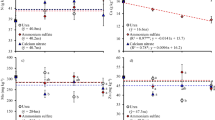Abstract
In studies on a sandy soil in Florida over a 3-yr period (1984–86), applications of Ca (CaSO4) inconsistently affected the bacterial soft rot potential of potato tubers (Solanum tuberosum). The potential was estimated from the severity of the disease (percent surface area decayed) in tubers that had been immersed in an aqueous cell suspension ofErwinia carotovora subsp.carotovora and then incubated 4 days in a mist chamber at 24 C. With freshly harvested tubers (tested within 5 days after harvest), disease severity averaged 49, 11, and 4% over all treatments in 1984, 1985, and 1986, respectively, which was roughly proportional to rainfall on the crop,e.g., 37, 18, and 15 cm, respectively. Disease severity decreased, did not change, and increased with increased Ca rate (0, 450, and 900 kg.ha-1) in 1984, 1985, and 1986, respectively. In each season, severity was affected by interactions involving the Ca treatments. Most interactions involved cultivar. The efficacy of Ca applications to potatoes grown in low Ca soils for enhancement of tuber resistance to bacterial soft rot may be limited by factors associated with environment or cultivar that are not completely understood.
Compendio
En estudios efectuados en un suelo arenoso de Florida durante un periodo de tres años (1984–1986), las aplicaciones de Ca (CaSO4) afectaron inconsistentemente el potencial bacteriano de la purdrición blanda de los tubérculos de papa (Solanum tuberosum). El potencial fue estimado por la severidad de la enfermedad (porcentaje de área de superficie afectada) en tubérculos que habían sido sumergidos en una suspensión acuosa deErwinia carotovora subsp.carotovora y luego incubada por cuatro días en una cámara nebulizadora a 24°C. Con tubérculos recién cosechados (probados dentro de los cinco días después de la cosecha), la severidad de la enfermedad promedió 49, 11 y 4% sobre todos los tratamientos en 1984, 1985 y 1986, respectivamente. La severidad de la enfermedad disminuyó, no varió y se incrementó con el incremento de la dosis de Ca (0, 450 y 900 kg.ha−1) en 1984, 1985 y 1986, respectivamente. En cada temporada, la severidad fue afectada por interacciones incluyendo a los tratamientos con Ca. La mayoría de las interacciones incluyeron al cultivar. La eficacia de las aplicaciones de Ca a las papas cultivadas en suelos de bajo contenido de Ca para mejorar la resistencia de los tubérculos a la pudricion blanda bacteriana puede ser limitada por factores asociados con el medio ambiente o el cultivar que no están totalmente comprendidos.
Similar content being viewed by others
Literature Cited
Bartz, J.A. and A. Kelman 1985. Effect of air-drying on soft rot potential of potato tubers inoculated by immersion in suspensions ofErwinia carotovora. Plant Dis 69:128–131.
Bartz, J.A. and A. Kelman 1986. Reducing the potential for bacterial soft rot in potato tubers by chemical treatments and drying. Am Potato J 63:481–493.
Cromarty, R.W. and G.D. Easton 1973. The incidence of decay and factors affecting bacterial soft rot of potatoes. Am Potato J 50:398–407.
Gander, P.W. and C.B. Tanner 1976. Potato leaf and tuber water potential measurements with a pressure chamber. Am Potato J 53:1–14.
Horsfall, J.G. and R.W. Barratt 1945. An improved grading system for measuring plant diseases. (Abstr.) Phytopathology 35:655.
Lapwood, D.H., P.J. Read and J. Spokes 1984. Methods for assessing the susceptibility of potato tubers of different cultivars to rotting byErwinia carotovora subspeciesatroseptica andcarotovora. P1 Pathol 33:13–20.
Lapwood, D.H. and P.J. Read 1985. A simplified slice method for assessing tuber susceptibility of potato cultivars toErwinia carotovora subsp.atroseptica. P1 Pathol 34:284–286.
Locascio, S.J., J.A. Bartz and D.P. Weingartner 1991. Calcium and potassium fertilization of potatoes grown in North Florida. I. Effect on leaf and tuber Ca and K contents and tuber yield and specific gravity. Am Potato J 68:000–000.
Lund, B.M. 1979. Bacterial soft-rot of potatoes. p. 19–49,In: D.W. Lovelock and R. Davies (Eds.)Plant Pathology. Soc Appl Bact Tech Ser No. 12, Academic Press, London/NY.
Lund, B.M. and A. Kelman 1977. Determination of potential for development of bacterial soft rot of potatoes. Am Potato J 54:211–255.
McGuire, R.G. 1983. Reduced severity of Erwinia soft rot in potato tubers with increased calcium content. Ph.D. dissertation, University of Wisconsin, Madison. 147 pp.
McGuire, R.G. and A. Kelman 1984. Reduced severity of Erwinia soft rot in potato tubers with increased calcium content. Phytopathology 74:1250–1256.
Pérombelon, M.C.M. and A. Kelman 1980. Ecology of the soft rot erwinias. Ann Rev Phytopathol 18:361–387.
Rhue, R.D., D.R. Hensel and G. Kidder 1986. Effect of K fertilization on yield and leaf nutrient concentrations of potatoes grown on a sandy soil. Am Potato J 63:665–681.
Ruehle, G.D. 1940. Bacterial soft rot of potatoes in Southern Florida. Fla Agric Exp Sta Bull 348. 36 pp.
Simmons, K.E. and K.A. Kelling 1987. Potato responses to calcium application in several soil types. Am Potato J 64:119–136.
Tzeng, K.-C., R.G. McGuire and A. Kelman 1990. Resistance of tubers from different potato cultivars to soft rot caused byErwinia carotovora subsp.atroseptica. Am Potato J 67:287–305.
Author information
Authors and Affiliations
Additional information
Florida Agricultural Experiment Station. Journal Series No. R01379.
Rights and permissions
About this article
Cite this article
Bartz, J.A., Locascio, S.J. & Weingartner, D.P. Calcium and potassium fertilization of potatoes grown in North Florida. II. Effect on the bacterial soft rot potential in the tubers. American Potato Journal 69, 39–50 (1992). https://doi.org/10.1007/BF02853409
Accepted:
Issue Date:
DOI: https://doi.org/10.1007/BF02853409




